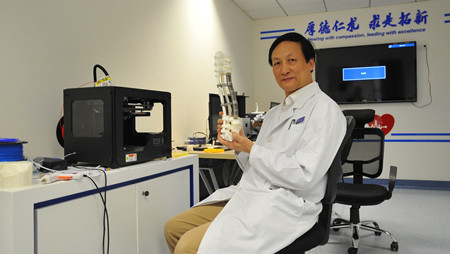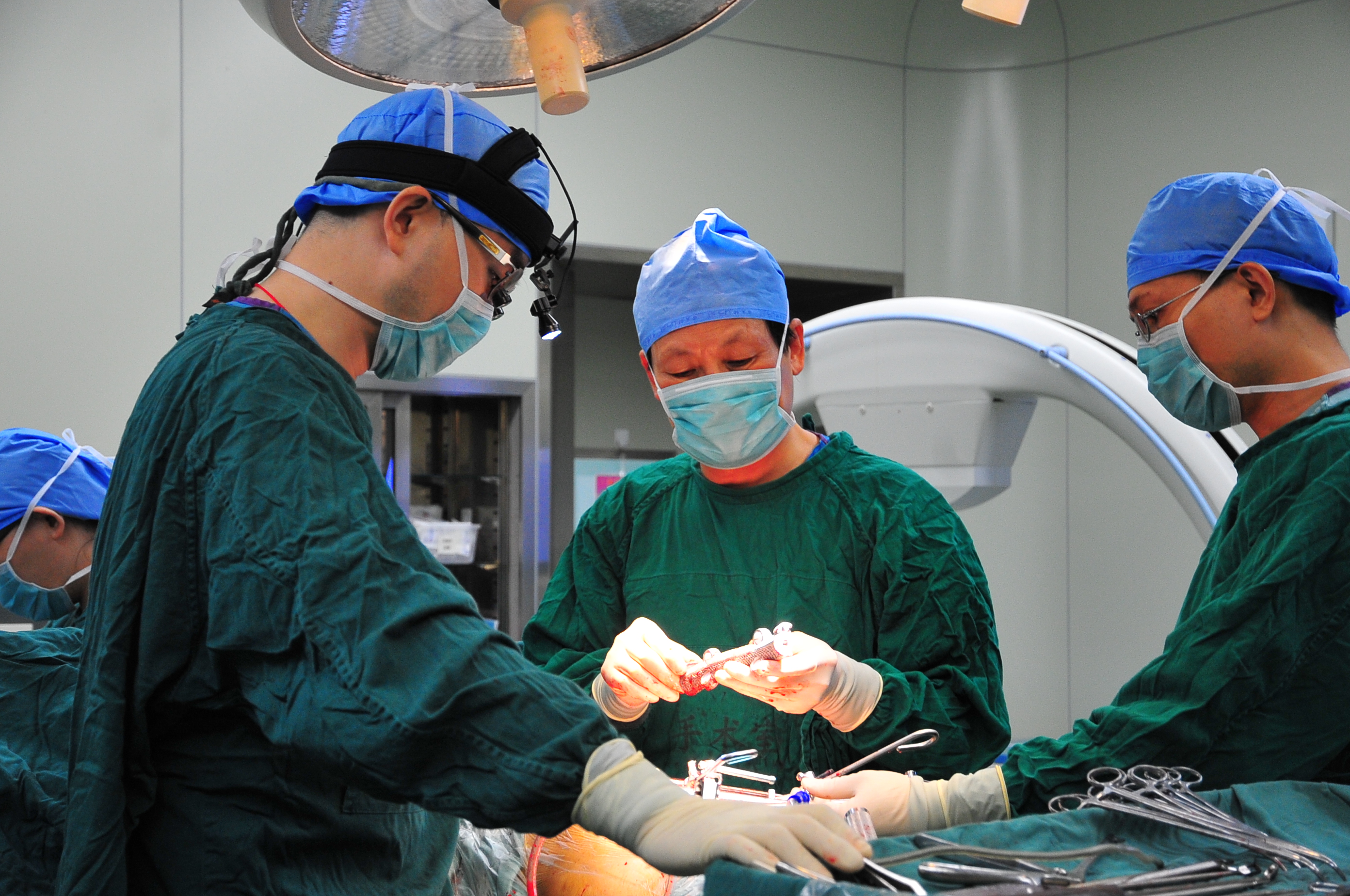Peking University, July 1, 2019: Professor Liu Zhongjun is a chief orthopaedic surgeon, Ph.D. advisor, and the director of the Department of Orthopedics at Peking University Third Hospital. He led a team of orthopedic doctors, professors, and engineers to research the use of 3D-printed titanium alloy implants in orthopaedic surgeries. In 2018, Liu’s team won the first prize of Beijing Municipal Science and Technology Award.

Professor Liu and a 3D-printed model
Turning to 3D printing to improve treatment method
Doctors at Peking University Third Hospital (PUTH), including Professor Liu Zhongjun, had long been probing into optimal treatments for spine tumor. However, after years of efforts, there was still one question remaining, i.e., how to make the recovery process easier. When removing the malignant tumor on the spine, surgeons often had to remove a portion of the backbone along with it. Surgeons would then implant a titanium cylinder filled with bone substance into the back of the patient. The cylinder would allow the vertebrae of the patient to grow and connect to the implant. However, due to the limitations of traditional manufacturing technology, the bone substance in the cylinder were in geometric shapes and would not perfectly fit the patient. It would take months and even years for the patient’s own bone to attach to the implant. During the process, the patient had no choice but to wear a heavy prop to prevent the migration of the implant. This all changed when Professor Liu saw the possibilities 3D printing had to offer.
Roughly a decade ago, 3D printers that can print objects made of metal came to the market. Professor Liu saw a huge potential in this new equipment. “As long as we could create a digital model, no matter how strange the shape of the model is, the newly-invented 3D printer can print a metal object according to the model,” said Liu. Therefore, it would be possible to make an exact replica of the removed bone of the patient, allowing for quicker recovery and better osseointegration. With this hope, when the long-term partner of PUTH, Beijing AKEC Medical Co., Ltd. (AKEC), bought a metal 3D printer, Professor Liu got in touch with the company immediately. He invited the company’s engineers to give lectures to doctors at the hospital. He also formed a research team composed of doctors at PUTH, engineers of AKEC and professors at PKU to conduct research on 3D printed implants.

A 3D-printed implant
From standardized products to customized implants
The first milestone the research team achieved was the three standardized, 3D-printed products they developed: artificial hip joints, vertebral prostheses, and interbody fusion cages. This was no easy task. According to Professor Liu, they encountered a lot of technological difficulties in the process and put a lot of efforts into solving them. The differences between the knowledge base of doctors and engineers were also causing them problems. For example, doctors in the research team wanted engineers to model a shape that could be easily described by an anatomy diagram. However, just using the anatomy diagram to describe it would leave the engineers very confused, as engineers did not have the necessary medical knowledge. In the end, they were able to find a solution — doctors in the team used modeling clay to build a rough model of the desired shape. The engineers then created a digital model which would in turn be subject to revision. In this way, they were able to collaborate with each other and make the previously unimaginable products a reality.
There was also one important question that Professor Liu’s team had to answer, i.e., whether the products would be safe. In order to test the safety of the products, they firstly started with animal trials and went on to conduct clinical trials in 2012. The phase of clinical trials for the three standardized products was completed in 2014 and the hip joint was the first among the three to be approved by China Food and Drug Administration (CFDA) in 2015. The other two products – interbody fusion cages and vertebral prostheses - also got CFDA approval in 2016.
However, for Professor Liu’s team, standardized products were not enough. Different people’s vertebrae are of different shapes, making customized vertebral prostheses desirable. The team went on to research the possibility of customization and implanted the first customized vertebrae in the world in 2014. The patient, a boy suffering from a malignant tumor on his neck, had a portion of vertebrae removed. The surgeons then replaced the removed vertebrae with a customized 3D-printed implant. Because the implant perfectly simulated the removed bone, the patient was able to recover quickly. Doctors also made pores in the implant so that the patient’s own bone could grow into and fuse with the implant, making the recovery even quicker.

Professor Liu implanting a 3D-printed object into the patient's body
The limitless potential of 3D printing
As demonstrated by the success of Professor Liu’s team, 3D printing offered a lot of opportunities in the field of orthopaedics. As Professor Liu summarized, 3D printing provided three benefits to orthopaedic patients. Firstly, using 3D-printed products, doctors can better treat common ailments such as cervical spondylosis. Secondly, diseases that had no ideal treatment method or even no cure in the past can now be treated. For instance, Professor Liu’s team once treated a patient with malignant tumor that had already affected five vertebrae. Removing such a large portion of the spine and replacing it with a prosthesis was unimaginable before 3D-printed implants were available. With 3D printing, Professor Liu’s team was able to create a 19-centimeter titanium alloy implant that perfectly matched the curvature of the patient’s spine, making the treatment possible. Thirdly, construction of intricate bone defects would be possible, as doctors are able to build pores in implants to make the patients’ own bone grow into the implants. In fact, Professor Liu’s team has already treated several cases of bone defects using 3D printing.
Looking to the future, Professor Liu saw the possibility of adding another dimension to the current 3D-printed implant. He and his team are now conducting cross-disciplinary research with researchers specializing in pharmaceutical sciences. They hope to find ways to add medicine in the pores of the implant to achieve effects other than just bone replacement. For example, if the patient suffers from osteomyelitis caused by external injury, doctors could add antibiotics to the pores of the implant to achieve an antibacterial effect.
True innovation and cross-disciplinary approaches are the keys to the future
Professor Liu and his team led the world in applying 3D printing technology to orthopaedic surgeries. Their success can be attributed to the innovative ideas they came up with. Innovation must center on treatment, the needs of patients and doctors; true innovation is goal-oriented and its value lies in its application, said Liu. As a Ph.D. advisor, Professor Liu often stresses to his students the importance of the ability to innovate. He is also glad to see that students today are more creative and less likely to get stuck in a rut than students ten years ago.
Furthermore, cross-disciplinary approaches would open doors to new possibilities. Just as Liu’s team revolutionized orthopaedics by capitalizing on the knowledge of different fields possessed by different team members, significant advancements in the future would need similar cross-disciplinary efforts. Professor Liu predicted that the curriculum of future medical students may also include engineering, and that of engineering students medicine, allowing them to better cooperate with each other and tap the technology-driven future of healthcare.
Advocating for equal quality of medical services
Besides being a successful doctor and researcher, Professor Liu is also a deputy to the National People's Congress, proposing policies for better healthcare. In 2019, Professor Liu submitted a motion on equal quality of medical services. His proposal stemmed from his observation that although more and more people have been covered by medical insurance, the quality of healthcare services people receive still differ from region to region. Patients in underdeveloped regions, after having visited doctors in their local area, often have to travel to large cities for better medical treatment.

Professor Liu briefing a patient on the surgery process
Professor Liu found this phenomenon a waste of medical resources and proposed three solutions. First, he proposed a training system for medical specialists. Under this system, those aiming to be medical specialists will receive extra training after they graduate from medical schools and will possess really high level of professional competence after they qualify for the position. Such a system increases the chances of competent healthcare professionals being available in remote area. Second, Professor Liu suggested that systematic efforts of helping doctors of underdeveloped area should be made, in order to alleviate the gap of the quality of care in different regions. Finally, Professor Liu pointed to telecommunication as the third solution: when encountering difficult cases, doctors in different regions can hold teleconferences to discuss the case together, thereby providing better treatment methods to the patient. In this way, geographical barriers can be overcome, and patients in underdeveloped area will also have access to high-quality medical services.
Reported by: Fan Kaixin
Edited by: Zhang Jiang



